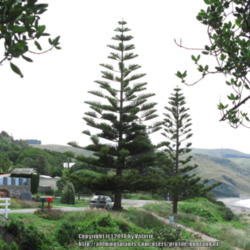| This year, as last, I bought a beautiful 4-foot Norfolk Island Pine for Christmas tree. Last year's died after about three months indoors, despite my best efforts -- its branches began to dry out and curl into claw-like shapes at the ends and gradually the entire plant dried out. (Yes, I was giving it water, though according to all instructions I'd received -- and the experience with my mother's plant -- I did let the soil dry somewhat to the touch before watering rather heavily.) The conditions in my apt. are not ideal -- I have only northwestern light and the windows all have blown-air heaters. However, I've done my best, as far as I can tell. I have two humidifiers running at all times and I have fed the new tree with Jobe's plant sticks. Yet now this tree is following last year's example. Three or four branches in the middle of the tree are beginning to dry out and curl under. Is there anything I can do to save the plant, or is it already too late? Any instructions on watering, feeding, need for artificial light in addition to the natural northwestern light, emergency care, etc, would be very greatly appreciated. (I should mention, in case you think it might be useful, that I do have a plant area near a window with an unused heater. However, that area is used for overwintering -- successfully, for the most part -- jasmine, fuchsia, rose geranium, patchouli and tibouchinna plants. Which means it is lit with two large "wonderlites" . ) Sorry to be so long winded, but I wanted to give you the full picture; I love my plants and want them to thrive, not die. |
| No, does not have any bugs plus he has been traveling with us since we got him 14 years ago. I am absolutely stumped what has happened to our little Norfolk Island Pine after all these years. We only have three, our Peace Lily that we have had for 20 years, Our Norfolk Island Pine in question and a Christmas cactus we have had a few years. Anyway thank you for all your help. Valerie Burns. |

This plant prefers cooler winter time conditions than are found in the average home, with temperatures ranging from about 40 to a maximum of 60 degrees being the preferred range. Moderate light (generally an east window is recommended) is adequate, as is moderate watering. Fertilizer is not needed during the winter as the plant growth slows in sync with the season. Based on your description it is difficult to give you a diagnosis, but there are several possible explanations for the problem ranging from general cultural conditions to injury from either insects or decorations. This tree is a large tree (up to 200 feet!) in nature and some individual plants simply do not tolerate prolonged container culture, particularly if allowed to become terribly rootbound. The plant may have been stressed before and/or after you bought it; most plants suffer to some degree during the retail process and subsequent adjustment to the home environment. Unfortunately, if the plant has been either over-watered or under-watered it may show a delayed die-back response from which it may or may not recover. It is also possible that the plant is suffering an insect infestation. Two possible culprits would be mealy bug and scale. Mealybugs are easily visible and look like little bits of bright white cottonball dotted on the branches. Scale can be found by inspecting very carefully in a bright light for little flat hard-shelled disks attached tightly and parallel to the surface. As it happens, mid winter is a prime time for scale to be a problem and it can be a difficult one to control. Mealybugs and immature scale can be treated with insecticidal soap according to the label instructions, or can be hand picked if the infestation is somewhat localized on the plant. Finally, it is possible that the weight of the ornaments (or heat from lights) damaged tissues while the tree was decorated and the damage is only now becoming apparent. In terms of emergency care, there isn't really an instant cure-all. Reducing the ambient temperature would probably be the one best thing you could do along with controlling insects if there are any on the tree. Good luck with your tree! |